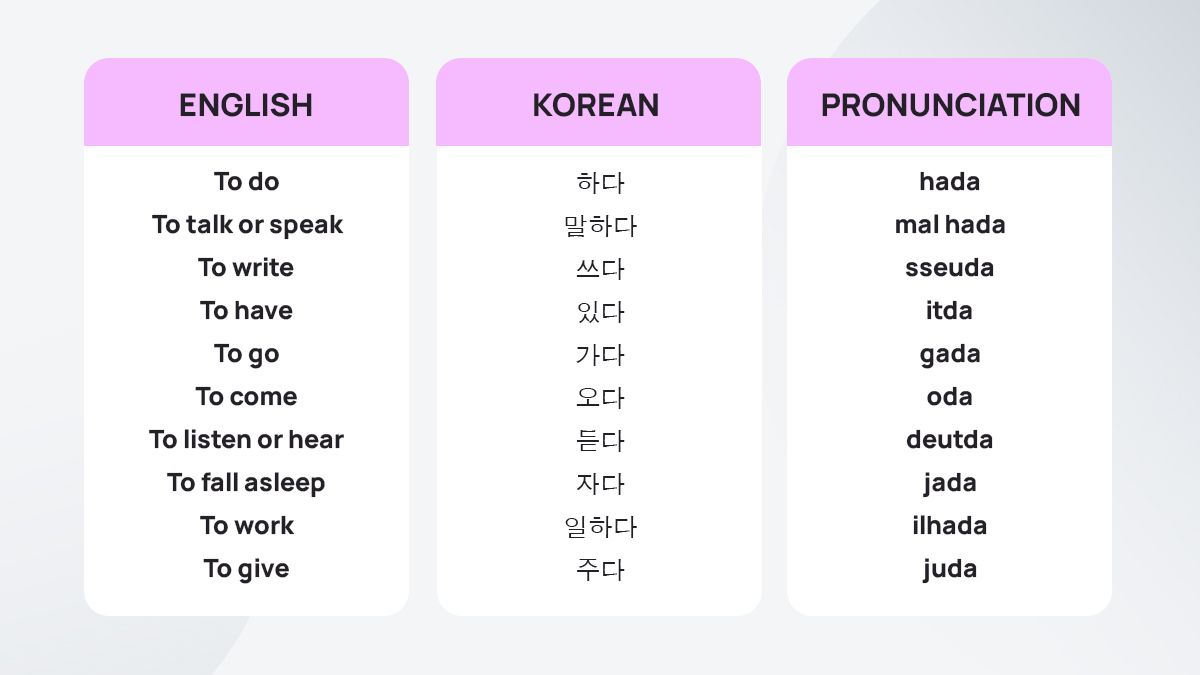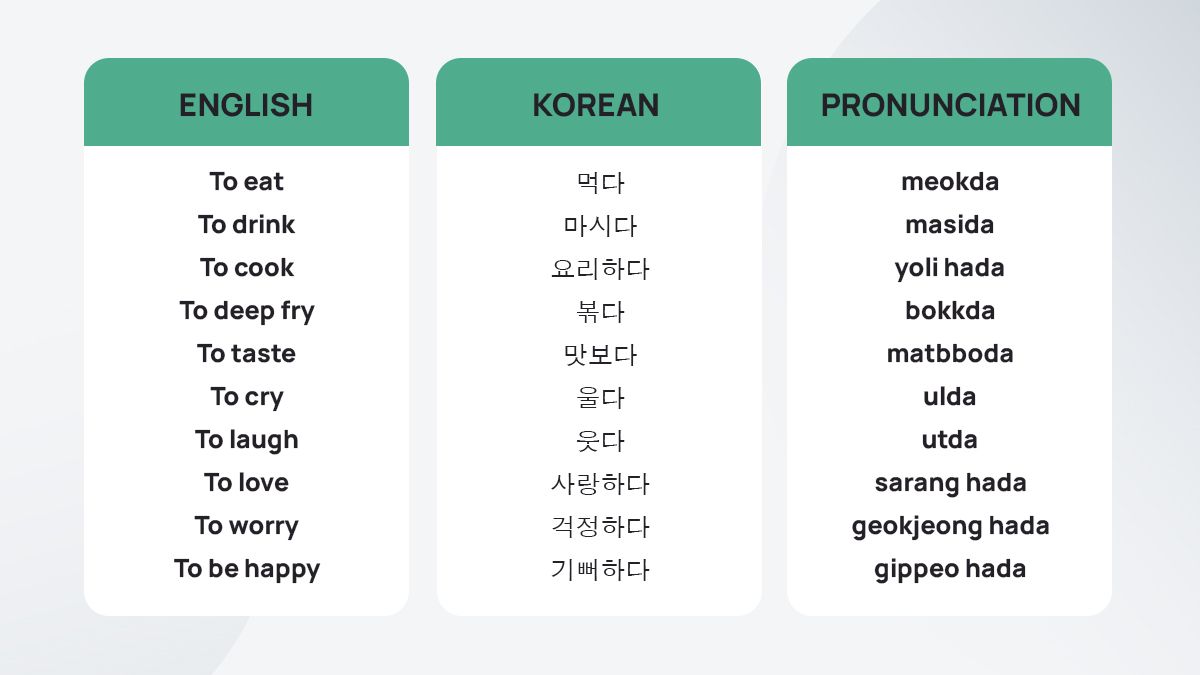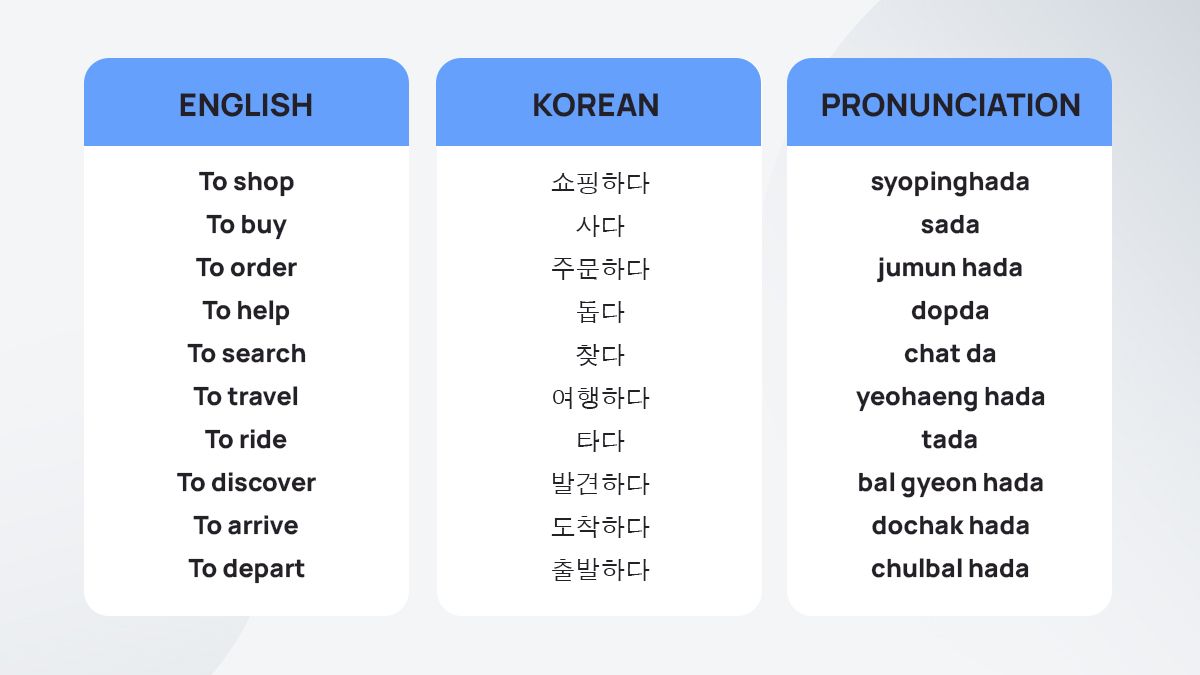With the surge in popularity of Korean culture in the world today, many people want to learn Korean. Some choose to do so for business reasons, but a lot of people just want to learn so that they can absorb Korean media more easily.
An easy way to start learning Korean grammar, as with learning other languages, is to practice some Korean verbs.
This article is a guide to some basic Korean verbs that will help you to start to get a grasp of the language.

Most Common Korean Verbs
When learning Korean, you will probably learn common words like "hello", "goodbye", and "thank you" first.
After this point, you will need to learn some common Korean verbs if you want to begin forming sentences.
One of the most important verbs in the Korean language is the verb "하다", or "hada", which means "to do". This is one of many important Korean verbs.
As you read through the Korean verbs below, pay attention to patterns and similarities. Some are descriptive verbs, some are existential verbs, and some are action verbs.
As you will see below, the Korean alphabet is extremely different from the Latin alphabet that you are used to. So, we have written the pronunciation of each common verb in the Latin alphabet before the actual word written in the Korean alphabet.
Take a few minutes to familiarize yourself with the 30 Korean verbs in dictionary form below before moving on to the next section of this article.
Related:

Popular Categories of Korean Verbs
10 Active Verbs
To do: hada (하다)
To talk or speak: mal hada (말하다)
To write: sseuda (쓰다)
To have: itda (있다)
To go: gada (가다)
To come: oda (오다)
To listen or hear: deutda (듣다)
To fall asleep : jada (자다)
To work: ilhada (일하다)
To give: juda (주다)

5 Verbs about Eating
To eat: meokda (먹다)
To drink: masida (마시다)
To cook: yoli hada (요리하다)
To deep fry : bokkda (볶다)
To taste: matbboda (맛보다)
Read Also:

5 Verbs to Express Emotion
To cry: ulda (울다)
To laugh: utda (웃다)
To love: sarang hada (사랑하다)
To worry: geokjeong hada (걱정하다)
To be happy: gippeo hada (기뻐하다)

5 Verbs for the grocery store
To shop: syopinghada (쇼핑하다)
To buy: sada (사다)
To order: jumun hada (주문하다)
To help: dopda (돕다)
To search: chat da (찾다)
5 Verbs for Travelling
To travel: yeohaeng hada(여행하다)
To ride: tada (타다)
To discover: bal gyeon hada (발견하다)
To arrive: dochak hada (도착하다)
To depart: chulbal hada (출발하다)

You may have noticed that each of these Korean verb endings end in the sound "-da".
The Korean character that creates that sound is "다", which you can also see is at the end of each word that is written in Korean script, or "Hangul".
We will not go into too much depth about hangul in this article, but this is an example of the slight similarity of word structure in English and Korean.
The different characters above are all different lengths and mark grammatical contrasts between different types of verbs. This visual will help you to understand the structure of a Korean verb for the rest of this article.
Korean Irregular Verbs
When learning Korean verbs, you will come across many irregular verbs as well as regular verbs.
Unfortunately, in Korean, an irregular verb cannot be spotted easily. The only way that you can know it is irregular is by seeing how the characters change when the verb is put in certain tenses.
Many common Korean verbs are irregular, including to walk, to ask, and to listen. Although they may seem tricky, the best technique for learning Korean irregular verbs is to take the time to memorize the most common ones.
Once you have them memorized, it will be easier to learn how to write them when you learn how to use Korean characters.
In order to get started on finding and memorizing irregular verbs, consider purchasing a Korean dictionary or find an online version that will list the most common irregular verbs.
Not all verbs are this tricky, but these will be the hardest ones to wrap your head around!
Korean Verb Conjugation Patterns
In Korean grammar, Korean verb conjugation can happen in many different ways depending on the context of the sentence in which it is being used.
With Korean verb conjugations, you need to have at least a basic understanding of Korean verbs and verb conjugation in general.
A Korean verb conjugation starts with a verb stem and a verb ending. The easiest Korean verbs to start with are the "hada" verbs.
If we look at the "hada" verbs, we can see that they all have the same verb endings. This is convenient because it means they will all have the same conjugation patterns.
So, once you practice verb conjugation with one "hada" verb, you will be able to do it with all of them.

Conjugating "Hada" Verbs
This is a very simple description of how to do a verb conjugation with a "hada" verb, just to get your brain wrapped around the concept.
We will use the example of an action verb in the list above: to travel or "yeohaeng hada".
Written out in Hangul, this Korean verb is "여행하다". As you can recall from above, the "hada" part of the word is how the verb ends, (하다).
So, when conjugating a verb in this way, you can modify nouns into verbs by adding the "hada" ending. In this context, the verb ending is the most important part of the word.
Korean Verb Conjugation versus English Verb Conjugation
Korean conjugations are similar to English in that they have a present tense, past tense, and future tense. However, for the most part, Korean verb conjugations differ from English verb conjugations.
This is because Korean is very contextual. Instead of focusing on other tenses like perfect or subjunctive, Korean grammar focuses more on the interaction between the speaker and their audience. To conjugate Korean verbs, you have to know who is talking to who.
For example, there are multiple versions of the present tense depending on who you are speaking to.
There is the present tense casual, there is the present tense formal polite, and there is the present tense informal polite, and that's just to name a few!
If a verb is not in casual tense, then it has an honorific suffix at the end of it.
See below the degrees of politeness that you must consider when conjugating verbs.
Casual versus Polite versus Formal
Korean is one of those languages in which the degree of respectfulness when addressing another person is extremely important.
In English, there are certain titles like "Sir" or "Madam" that we use when addressing people of importance or seniority, but we don't really change verbs in order to adjust to whom we are speaking.
One of the grammatical contrasts between English and Korean is that in Korean, a verb can be conjugated to a different verb tense (present, past tense, future tense, etc.). However, within each time frame conjugation, it also has to be conjugated to be casual or polite, or formal.
The way to change a Korean verb from one degree of respect to another is by changing the ending of the verb.
Changing a verb from casual to polite or formal is called changing its "honorific form", as you are honoring the person with whom you are speaking.
This is a very complicated dance of prefixes and suffixes and can very easily be done incorrectly. If a verb stem ends in a vowel, you have to add a specific suffix, but if it ends in a consonant, you add a completely different character to the end of the verb. This also goes for creating passive forms of verbs!
It is also important to pay attention to your speech level. A person's speech level is very different between a formal polite context and a casual one.
For example, speech levels between an employer and an employee will differ from speech levels between friends. Although this sounds complicated, all it takes is some practice and repetition.

Korean Sentence Structure
Korean verbs are at the heart of sentence structure in the Korean language. In Korean, the verb always ends the sentence.
You will not be able to start to understand or speak Korean if you do not first learn how to use a verb in a sentence. Another thing to look out for is using appropriate conjugation patterns.
We have only scratched the surface in this article, but there is so much more to learn about how to conjugate verbs with different verb endings or beginnings.
A verb is the core of a sentence and everything else builds around it. One verb can create a complete thought depending on all the suffixes that may be added to it, but you will usually also need a noun and connecting words.
In other languages, sentence structure is much different, so keep that in mind when you are starting to learn to form Korean sentences.
Learning Korean Verbs in Everyday Life
There are many ways that you can look out for the verbs that you have learned in this article and learn even more verbs in your day-to-day life.
One way is to listen to Korean learning podcasts. Many podcasts spend whole episodes explaining just verbs and putting them into real-life context.
All you have to do is search for "Korean learning podcasts" on whatever listening platform you use, and a lot will pop up. You can even listen to one new Korean word per day.
Movies and TV shows in Korean have become very popular in recent years and are one of the easiest ways to pick up Korean verbs. Next time you can't figure out what to watch, try to put on a Korean Movie or TV Show on Lingopie. We even have an article to help you pick the best K-Dramas to watch!
We recommend you put on the dual-subtitle feature, and write down some target language that you want to learn.
You can also read Korean magazines or blog posts. When you feel ready, maybe pick up an easy-to-read Korean book. Most classic and familiar English books have also been translated into Korean, so that may be a good place to start!
If you're familiar with Japanese mangas, you may want to try to read Korean webtoons which are very similar and will help you improve your reading skills.
Keep an eye out for a passive verb here, descriptive verbs there, or verbs in different tenses as you read.
FAQs about Korean Verbs
How many verb tenses are there in Korean?
Korean primarily uses three verb tenses: past, present, and future. Each tense can be further modified to express different levels of formality and politeness, but the core tenses remain these three.
How many Korean verb endings are there?
Korean verbs have numerous endings, depending on the tense, mood, and level of politeness being conveyed. There are dozens of common endings, but learning the most frequently used ones can provide a strong foundation. For example, common endings include -습니다 (formal), -아요/어요 (polite), and -아/어 (informal).
What is the verb Hada in Korean?
The verb "하다" (hada) in Korean means "to do." It is one of the most versatile and commonly used verbs in the language, often used to form compound verbs with nouns, such as "공부하다" (gongbu-hada) meaning "to study."
Does Korean have irregular verbs?
Yes, Korean has several irregular verbs that do not follow the standard conjugation rules. Some common irregular verbs include "듣다" (to listen), "걷다" (to walk), and "돕다" (to help). These verbs require special attention when learning their conjugations.
How do you memorize Korean verbs?
To memorize Korean verbs, it helps to use a combination of methods:
- Flashcards: Create flashcards with the verb on one side and its meaning and conjugations on the other.
- Practice: Regularly use the verbs in sentences and practice speaking and writing.
- Association: Associate verbs with actions or images to create mental connections.
- Repetition: Repeatedly review and practice the verbs to reinforce memory.
- Apps and Tools: Utilize language learning apps and tools that offer spaced repetition and interactive exercises.
Summing up: Korean Verbs for Beginners
In this post, we've taken you through some common Korean verbs, basic conjugation, verb stem and suffix changes, and conversational context.
Now that you have seen some Korean verbs in context and gotten a taste of Korean conjugation, you can start noticing Korean verbs in your life.
Whether you're practicing putting Korean verbs into past tense and future tense, turning nouns into verbs, or practicing Korean conjugation, we hope that this information was a good starting point.
Why not dive into Korean learning through Lingopie? Lingopie provides a way to learn Korean through movies and TV shows. Sign up now for a 7-day free trial and see how watching Korean TV shows can help you to learn this fascinating language!








![11+ Best Shows On Netflix To Learn Korean [2025]](/blog/content/images/size/w300/2025/05/Best-Shows-On-Netflix-To-Learn-Korean.jpg)

